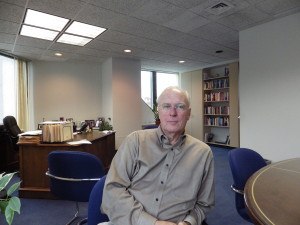Information central
Statistics gathered The Business Council of Fairfield County say it”™s time to make room for Stamford among the world”™s international cities: polyglot and thrumming.
For the last five years, 60 percent of births there have been to foreign-born women and fully one-third of four-year degree holders are foreign-born.
Eye-opening as those statistics are, they barely scratch the surface. An hour with Chris Bruhl, president and CEO of The Business Council of Fairfield County, reveals the melting pot spreads countywide, with one in five county residents foreign-born.
“This was not so 15 years ago,” he said. “Stamford is now a global city.”

That knowledge could prove golden for someone with an idea to reach the immigrant economy. Another data set might open another door. An introduction might lead to a business deal or a loan. The emphasis is local, but the Business Council acknowledges the huge impact of Hartford and New York City and gathers their masses of data and regulations. Business Council areas of concern fall into two broad categories: “the tangible” and “the tactical.”
“Our field has been geographically defined,” Bruhl said. “We”™re not trying to change Wichita.”
Bruhl is in his mid-60s and he peppers his thoughts with the appropriate Buffalo Springfield quote. His confidence is backed by an undergraduate degree from Brown University, an MA in English literature from LSU and an MBA from NYU”™s Stern School of Business. Tieless on a recent Friday, he exuded ease among the din of statistics that surround him and that he shares without notes. Knowledge of immigration trends spills into macroeconomics with the observation, “In reality, economies are large, sprawling, unpredictable.”
One year ago this month, the Business Council began its Growth Advisory Services with the idea of establishing “growth-oriented relationships” for promising companies. So far, the program has helped 20 companies, including GoECart, LogicBroker, Owlstone and Q-Bank Group. The four companies on Sept. 24, 1:30-3:30 p.m., at 4 Landmark Square Conference Center in Stamford, will participate in a review the program for potential investors, members of the council”™s Growth Network, board members, corporate innovation team leaders and others interested in early exposure to growing companies.
“All in a day”™s work” at the Business Council involves historic perspective (“autos replacing rails and now the resurgence of rail and transit hubs”); analyzing the intersection of regional Fed policy and economic policy from Hartford; plus analysis in the arenas of taxation, infrastructure, schools, health, families and even faith.
“From June to December we address regional issues and trends, briefing philanthropists, chambers of commerce and religious leaders on key issues like health,” Bruhl said. “A particular point of interest is small business. Larger employers have an interest in these topics, but they have different challenges.” The first half of the year is focused more on legislation and policy.
Even after 22 years on the job, Bruhl said he “stands on the shoulders” of those who came before, notably John Mitovich, the director who preceded him and who died in 2007.
“John Mitovich was here 20 years, starting in 1968 or ”™69,” Bruhl said. “He stressed policy, procedure and personality. He would rather lose a board member than have a non-decision maker on the board. If he allowed that, the CEO pretty soon would delegate to the director of community affairs. Without the decision makers, the formula would not have worked. You have to involve the decision makers directly or nothing gets done. John Mitovich built that culture within a sphere of activity ”” and, boy, has that served us to this day.”
Bruhl said that, besides Stamford where the Business Council is headquartered, the council has members from Danbury to Bridgeport to Norwalk.
The council employs 12. Its annual budget is $2.1 million, with 75 percent from private funding and the remaining funding coming from the federal Small Business Administration, the Environmental Protection Agency, the Department of Labor and from the state Department of Energy. The Business Council also now partners with the state Department of Economic and Community Development and for small business help it works with SCORE ”” the Service Corps of Retired Executives.
The council”™s Growth Network consists of 50 executives from 31 companies who meet monthly.
“For some things, we”™re the only ones gathering data and referrals, offering support and direction,” Bruhl said. “The object is not to own it all. The object is to get it all done. We think of ”˜network”™ as a noun ”” something to build, to manage. It is robust, dynamic.”
The council, now headquartered at 1 Landmark Square, dates to 1890 when it was called the Stamford Board of Trade. Through much of the 20th century it was the Stamford Chamber of Commerce, which is not the same as the current chamber, dating to the 1980s and at 733 Summer St.
In 1970, the Business Council was called the Southwestern Area Commerce and Industry Association, a merger of several Nixon-era business organizations. The Business Council became known as such eight years ago.
The name changes were not arbitrary. Rather, they reflected what Bruhl called, “an evolving picture of representation that is consistent across the country. We reflect larger companies and policies, which differentiates us from chambers. We see ourselves as a business organization focused on issues that affect businesses or that businesses can affect.”
Bruhl directed the Westchester Arts Council until 1990 when he joined the Business Council. He cited a difference between Westchester, where a county government model offers pertinent data through its Planning Department, and town-oriented Connecticut.
“Connecticut has no regional data,” he said. But that began to change 22 years ago when Bruhl came aboard.